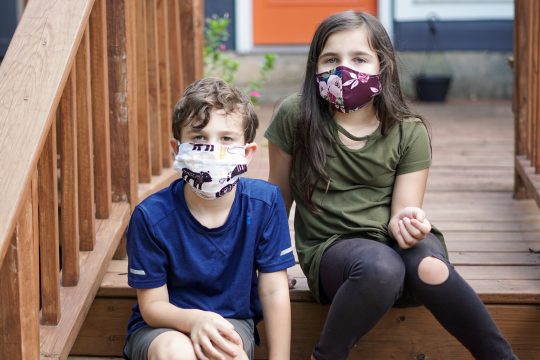 Without another Relief Bill from Congress, a Growing Number of Families Cannot Afford to Put Food on the Table
Without another Relief Bill from Congress, a Growing Number of Families Cannot Afford to Put Food on the Table
October 28, 2020
By Katherine Ungar, JD, Policy Associate
The pandemic casts a looming shadow on the state of childhood hunger in our country and right here in Ohio. Feeding America, a national hunger relief organization, predicts that 1 in 4 children could be food insecure by the end of 2020, up from 1 in 7 children in 2019. In a recent household pulse survey by the US Census Bureau, 11.1 percent of adults in Ohio reported that their households “sometimes or often did not have enough food to eat” in the past seven days.
Record-setting unemployment, loss in health care coverage, unexpected expenses, and lack of access to school meals, are among the myriad of reasons why the pandemic has caused a rise in the number of hungry children and families.
Food insecurity not only can impede a child’s ability to develop and learn, but also can cause serious health issues. Children who don’t get enough to eat are more likely to be hospitalized and face higher risks of health conditions like anemia and asthma, putting them at a serious disadvantage at the start of life. Children who struggle to get enough to eat are more likely to repeat a grade in elementary school, experience development impairments in areas like language and motor skills, and face more problems in school and other social settings. Congress MUST act quickly to pass a second relief package in order to keep our children fed and prevent them from going hungry.
Food Insecurity Spikes are reflected here in Ohio
To feed their families, many parents rely on local food banks, drive-thru pantries, school meals, and critical federal programs such as SNAP and WIC.
From March through June, more than 2.9 million Ohioans were served by a pantry or food bank, an all-time record high for the foodbanks in Ohio. And, the need for food assistance is also reflected in applications for the Supplemental Nutrition Assistance Program (SNAP) benefits, formerly known as food stamps. Applications surged in Ohio during the first two months of the pandemic then dropped back to more normal levels after Congress approved a massive stimulus package that included $600 in additional monthly unemployment benefits. However, as those additional monthly unemployment benefits ended in July, SNAP applications picked up again in August.
Congress MUST act to provide relief and improve food access and pass a second stimulus bill, the HEROES Act, which has been stuck in Congress for months now. We cannot let food insecurity and hunger set our children back. Policymakers must do everything they can to improve and increase access to food for all of Ohio’s children and families.
The House of Representatives released their recently updated HEROES Act (HEROES 2.0), which includes important measures to help families put food on the table.
As I wrote about here, the House of Representatives, back in May, passed the HEROES Act which would have provided much needed relief to families. Recently, in an effort to compromise with the Senate, the HEROES Act was updated. Importantly, HEROES 2.0 still includes critical relief for food assistance programs for children and families. Among other things, HEROES 2.0 would:
- Increase the maximum SNAP benefit by 15%, raise the minimum monthly allotment, and allow SNAP recipients to purchase of hot food products
The HEROES Act provides for a 15% increase in the SNAP maximum benefit and increases the minimum monthly allotment from $16.00 to $30.00. The bill also increases food access by allowing SNAP recipients to use their benefits to purchase hot foods or hot food products ready for immediate consumption until the end of the COVID-19 emergency.
Not only does the SNAP increase support children and families, but also stimulates our economy. Not surprisingly, SNAP applications in Ohio have surged as a result of the pandemic.
Standard SNAP benefits are too low to adequately feed many families and almost half of families use their monthly allotments within the first few weeks of the month. Families’ food budgets are being stretched and an increase in SNAP benefits will not only provide relief for Ohioans, but will also result in an economic stimulus as these dollars are spent at Ohio retailers and grocery stores.
- Provide emergency relief to help school meal and child and adult care food programs (CACFP), which are in need of financial assistance in order to continue to serve children and families at their current capacities.
The bill would allocate as much funding as necessary for these important feeding programs to continue to feed children and adults throughout Ohio. Increased funding will allow our child nutrition providers across the state to meet the need and increase capacity.
- Provide schools increased flexibility to provide children in low-income communities with fresh fruit and vegetable snacks through the Fresh Fruit and Vegetable Program (FFVP).
This part of the Act recognizes that need to give our kids healthy and nutritious foods. When children are faced with unhealthy sugary choices, they often pay the price physically and with lifelong consequences. In fact, the Robert Wood Johnson Foundation recently released a report that found that 1 in 7 American children are obese.
- Provides $400 million for Special Supplemental Nutrition Program for Women, Infants, and Children (WIC) to fund an increased value of the WIC Cash Value Voucher for women and children over a four-month period.
WIC is a critical public program that provides federal grants to states for supplemental food, health care needs, and nutrition education to low-income pregnant, breastfeeding, and non-breastfeeding postpartum women and to infants and children up to age five who may be at nutritional risk.
- Raises the age of eligibility from 18 to 25 years for participation in the Child and Adult Care Food Program (CACFP) at emergency homeless shelters during the pandemic.
This provision would be very helpful for youth and family serving homeless shelters by expanding the age of eligibility for participation in the CACFP program from 18 to 25 years. From a list of CACFP providers in year 2020, 15 appear to be operating as emergency shelters and would be able to serve meals to more children as a result of this provision.
- Protects college student eligibility for the Supplemental Nutrition Assistance Program (SNAP) during the COVID-19 public health emergency by clarifying that work study eligibility- rather than enrollment- is sufficient to confer eligibility for SNAP.
In Ohio, one in five children live in poverty and as those children grow into late adolescence and young adulthood, their economic situation is just as challenging. As a result, many youth and young adults who make it to college continue to struggle to make ends meet. They include emancipated youth from the child welfare system, young parents, and other youth who do not have the safety net of parents with resources. This provision ensures that these struggling youth in college do not lose their SNAP eligibility due to work study or job loss during the pandemic.
In addition to strengthening food assistance programs for families, The HEROES Act invests in our national public health response, providing $75 billion to support testing, contact tracing, and isolation measures. The bill also helps millions of people who lose their jobs and as a result, their health benefits, purchase affordable marketplace coverage and provides much needed health and economic support to communities and families. The time is NOW for congress to act to prevent more children from experiencing hunger.

